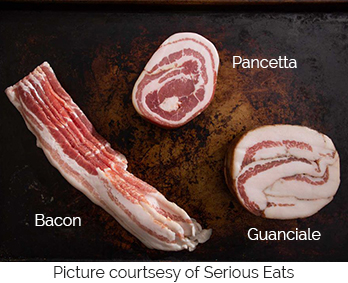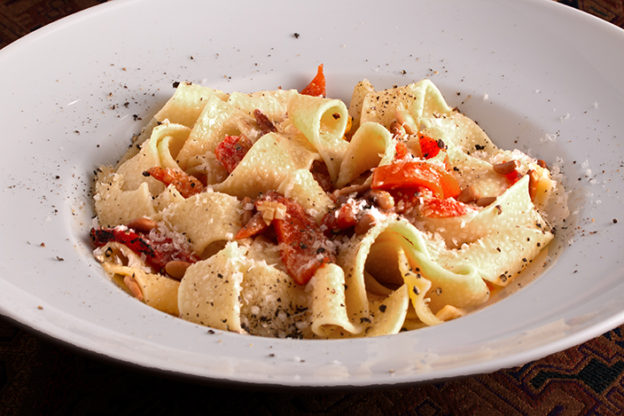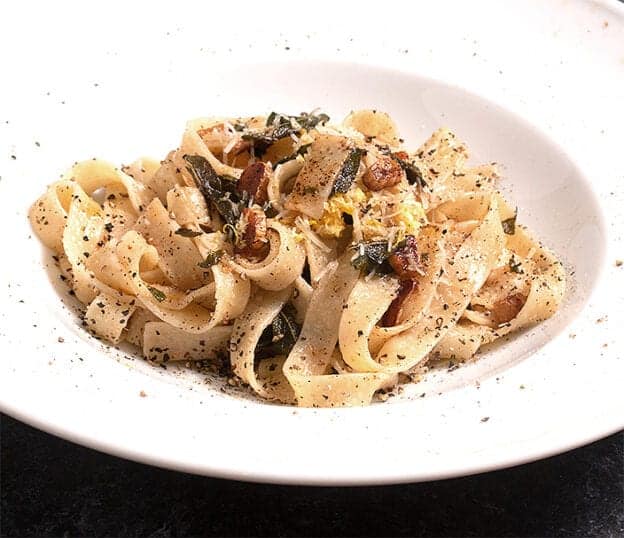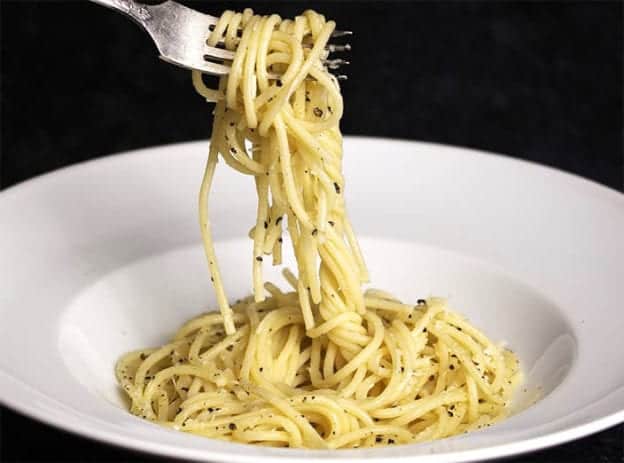Prep time 10 min cook time 15 min
This is the original Roman recipe for cooking Spaghetti Carbonara.
Spaghetti Carbonara must be one of Rome’s biggest culinary gift to the world. Recently, a Roman friend who was visiting us cooked this dish. It was a masterpiece based on the original recipe that is very different to what I was used to and what usually passes for a Carbonara.
The dish is a simple one with few ingredients and because of that the quality of each one is imperative. There are also some traditional guidelines to follow.
To start with, the choice of pork cut is important. 
It may be difficult to come by and Pancetta is one alternative. It comes from the belly of the pig but is cured on the salty side. Then there is bacon which is frowned upon by purists but is tolerated. It is my preferred substitute to guanciale because it is not as salty as pancetta.
The choice of cheese is limited to Parmesan or the sharper tasting and saltier sheep’s cheese, Pecorino whose origin is also Roman. You can have a combination of both but the rule is that they must be freshly grated.
The pasta is also important. Fresh is obviously preferred but the dry versions also work. Spaghetti is the usual choice and bucatini which is a thicker, tubular pasta is also acceptable.
Then comes the sauce that gives the dish its characteristic creamy texture. The biggest no-no when making a real carbonara sauce is adding cream. The creaminess of the pasta dish should only come courtesy of the raw egg and cheese with the addition of some of the reserved cooking water. They blend together to coat each strand of pasta and give the dish its typical richness.
Spaghetti Carbonara
by
Derek Farwagi
Equipment
- large saucepan to boil water
- a large non stick frying pan You need a large frying pan because once cooked, you will mix the spaghetti in the frying pan with the rendered pork chunks. If you do not have a large frying pan, cook the pork in as large a saucepan or Dutch oven as you have then mix the pasta in that.
- a medium bowl to beat the eggs and mix in the grated cheese
Ingredients
- 1 large egg at room temperature
- 1 large egg yolk at room temperature
- ½ cup freshly grated parmesan or pecorino cheese (or combination of both)
- 3-4 oz guanciale coarsely chopped in chunks. (substitute with pancetta or bacon)
- 1 tbsp olive oil
- 8 oz dried spaghetti
- salt and pepper to taste
Instructions
- Fill a large pot with about 3 quarts of water, add a tsp of salt and place over high heat and bring to a boil.
- While the water is coming to a boil, use a medium bowl to beat the eggs till smooth a runny. Add the cheese and mix with a fork till well blended and creamy. Season with a generous amount of black pepper. Set aside.
- In a large frying pan over medium-high heat, cook the chunks of pork meat until the meat begins to brown and the fat is rendered ( 5 to 6 minutes). Set aside.
- Remove about 1 tablespoon of the rendered fat and add it to the egg mixture to begin to temper the sauce, quickly whisking again with the fork.
- When the water comes to a boil, add the spaghetti and stir until all the strands are submerged. Cook according to the package instructions, stirring occasionally, until the pasta is al dente.
- When the pasta is ready to your liking, lift out the unstrained pasta with tongs and quickly stir it and any pasta liquid that drips from it into the frying pan with the rendered pork. You want to stir quickly so the pasta remains hot to partially cook the eggs during the next step.
- Quickly pour the egg and cheese mixture and stir vigorously to avoid curdling the eggs. If too dry, add a little pasta water till you get the consistency of the sauce you want. It should be creamy but not too runny. (If you overdo the water, you can always thicken the sauce by heating the pasta on a low fire and keep stirring until the sauce thickens to your liking).
- Serve with a topping of grated cheese and ground pepper.






GET INSPIRED. SUBSCRIBE NOW.